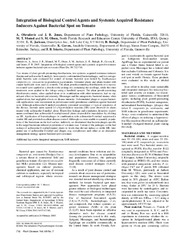Приказ основних података о документу
Integration of biological control agents and systemic acquired resistance inducers against bacterial spot on tomato
| dc.creator | Obradović, Aleksa | |
| dc.creator | Jones, Jeffrey B. | |
| dc.creator | Momol, Timur M. | |
| dc.creator | Olson, SM | |
| dc.creator | Jackson, LE | |
| dc.creator | Balogh, B | |
| dc.creator | Guven, K | |
| dc.creator | Iriarte, FB | |
| dc.date.accessioned | 2020-12-17T18:32:45Z | |
| dc.date.available | 2020-12-17T18:32:45Z | |
| dc.date.issued | 2005 | |
| dc.identifier.issn | 0191-2917 | |
| dc.identifier.uri | http://aspace.agrif.bg.ac.rs/handle/123456789/1017 | |
| dc.description.abstract | Two strains of plant growth-promoting rhizobacteria, two systemic acquired resistance inducers (harpin and acibenzolar-S-methyl), host-specific unformulated bacteriophages, and two antagonistic bacteria were evaluated for control of tomato bacterial spot incited by Xanthomonas campestris pv. vesicatoria in greenhouse experiments. Untreated plants and plants treated with copper hydroxide were used as controls. The plant growth-promoting rhizobacteria or a tap water control were applied as a drench to the potting mix containing the seedlings, while the other treatments were applied to the foliage using a handheld sprayer. The plant growth-promoting rhizobacteria strains, when applied alone or in combination with other treatments, had no significant effect on bacterial spot intensity. Messenger and the antagonistic bacterial strains, when applied alone, had negligible effects on disease intensity. Unformulated phage or copper bactericide applications were inconsistent in performance under greenhouse conditions against bacterial spot. Although acibenzolar-S-methyl completely prevented occurrence of typical symptoms of the disease, necrotic spots typical of a hypersensitive reaction (HR) were observed on plants treated with acibenzolar-S-methyl alone. Electrolyte leakage and population dynamics experiments confirmed that acibenzolar-S-methyl-treated plants responded to inoculation by eliciting an HR. Application of bacteriophages in combination with acibenzolar-S-methyl suppressed a visible HR and provided excellent disease control. Although we were unable to quantify populations of the bacterium on the leaf surface, indirectly we determined that bacteriophages specific to the target bacterium reduced populations of a tomato race 3 strain of the pathogen on the leaf surface of acibenzolar-S-methyl-treated plants to levels that did not induce a visible HR. Integrated use of acibenzolar-S-m ethyl and phages may complement each other as an alternative management strategy against bacterial spot on tomato. | en |
| dc.publisher | Amer Phytopathological Soc, St Paul | |
| dc.rights | openAccess | |
| dc.source | Plant Disease | |
| dc.subject | integrated management | en |
| dc.subject | SAR inducers | en |
| dc.title | Integration of biological control agents and systemic acquired resistance inducers against bacterial spot on tomato | en |
| dc.type | article | |
| dc.rights.license | ARR | |
| dc.citation.epage | 716 | |
| dc.citation.issue | 7 | |
| dc.citation.other | 89(7): 712-716 | |
| dc.citation.rank | M22 | |
| dc.citation.spage | 712 | |
| dc.citation.volume | 89 | |
| dc.identifier.doi | 10.1094/PD-89-0712 | |
| dc.identifier.fulltext | http://aspace.agrif.bg.ac.rs/bitstream/id/17/1014.pdf | |
| dc.identifier.scopus | 2-s2.0-20644460780 | |
| dc.identifier.pmid | 30791240 | |
| dc.identifier.wos | 000230053900004 | |
| dc.type.version | publishedVersion |


